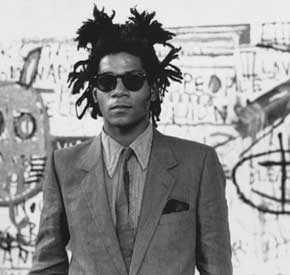 By Nelly Spigner
By Nelly Spigner
Art has saved lives. Whether it has been through writing, movies, or painting, many people have named art as a huge influence in their lives. So I always find it interesting that people don’t think of artists as heroes.
I might even go as far as saying that the art world is that of many unsung heroes. One such hero goes by the name of Jean Michel Basquiat. A well known name within the black community but not in the majority. So whats so great about a homeless graffiti artist from New York, who made it big time in the art world during the 80’s? Well, just about everything.
Basquiat was born to a Haitian-American father and a Puerto Rican mother in Brooklyn, New York. A self-taught artist, Basquiat first attracted attention for his graffiti in New York City in the late 70s, under the name “SAMO,” standing for ‘same old shit.” He was homeless for sometime but to make ends meet, he sold sweatshirts and postcards featuring his artwork on the streets of his native New York. Soon though, his work and style received critical acclaim for fusing of words, symbols, stick figures, among other things. People began paying as much as $50,000 for a Basquiat original.
His story sounds like the classic “rags to riches” script but there is so much more complexity to his tale. Basquiat was born during the aftershock of the civil rights movement, during the time black at was still considered “street art” and street art was considered to be the equivalent to nothing. Of course Basquiat knew this, but more importantly Basquiat felt this and still pursued his dreams because he was part of something bigger. This time period during the late 70’s and early 80’s was also referred to as the “Black Arts Era” a movement in which called for a  complete liberation from the chains of the past, all the while producing a culture they could be proud of.
complete liberation from the chains of the past, all the while producing a culture they could be proud of.
So not only did Basquiat’s paintings make it from the streets to institutions, they also carried with them meaning for the black youths during that age and for many years to follow.
Basquiat once said, “The black person is the protagonist in most of my paintings. I realized that I didn’t see many paintings with black people in them.“ His work challenged the majority’s mindset but creating images that honored black men as kings and saints. With his signature recurring motif, the crown, he recognized the majesty of his black heroes including groundbreaking athletes, musicians and writers, all the while reminding other people of them and instilling pride in the black community.
Like many heroes, Basquiat had a fatal flaw, his drug abuse. Unfortunately, his life ended in his prime at the age of 27, in 1988. But even in his short lived life he made a giant impact, and that is heroic. He has a legacy shaped by his charisma, magnetism, and rebelliousness. He stood as an underdog who challenged assumptions, authorities, and agencies of the culture he was born into. He essentially said, I’m black hear me roar without having to say a word, and that message continues to resonate with people today. That’s why I deem Basquiat a hero. A culturally queer hero for kings and queens who didn’t know they were royalty.
– – – – – – – – – – – – – – – – – – – – – – – – – – –
Nelly Spigner is an undergraduate enrolled in Scott Allison’s Heroes and Villains First-Year Seminar at the University of Richmond. She composed this essay as part of her course requirement. Nelly and her classmates are contributing authors to the forthcoming book, Heroes of Richmond, Virginia: Four Centuries of Courage, Dignity, and Virtue.